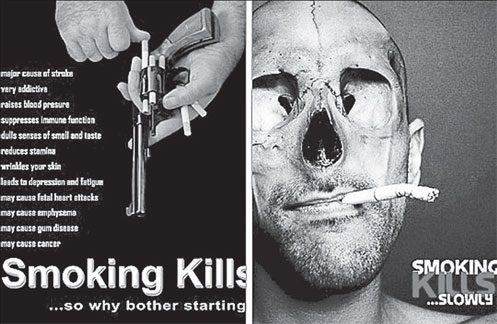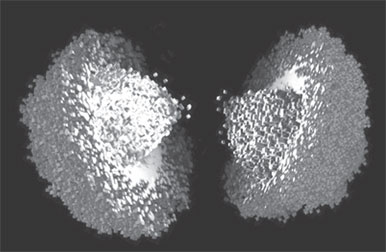|

Worldwide call for larger pictorial health warnings
by Manjari Peiris
The FCTC Article 11 guidelines recognise that the effectiveness of
health warnings increases with size - A larger size means that warnings
are more visible, more important, and have more impact. A larger size
allows for bigger and better pictures, a larger font size and/or
additional information, including cessation information.
A larger size makes it more difficult for the branded promotional
part of the package to distract the consumer’s attention away from the
warning. That larger sizes are more effective is confirmed by the
considered decisions of governments worldwide where the trend is very
much to increase warning size.
 All the Parties to the international tobacco control treaty of the
World Health Organisation (WHO) - Framework Convention on Tobacco
Control (FCTC) should have been implemented the treaty’s Article 11 -
which is Pictorial Health Warnings on tobacco products within three
years after the FCTC comes into force for that Party. All the Parties to the international tobacco control treaty of the
World Health Organisation (WHO) - Framework Convention on Tobacco
Control (FCTC) should have been implemented the treaty’s Article 11 -
which is Pictorial Health Warnings on tobacco products within three
years after the FCTC comes into force for that Party.
Sri Lanka ratified the treaty in 2003 and the FCTC came into force in
2005. Pictorial Health Warning regulation is one of the five key
policies of WHO to reduce tobacco consumption - MPOWER.
Pictorial health warnings (PHW) on tobacco products constitute the
most cost-effective tool for educating smokers and non smokers alike
about the health risks of tobacco use. In many countries, more smokers
report getting information about the health risks of smoking from
warning labels than any other source. PHWs also provide high awareness
to non-smokers, including children of the danger of tobacco smoking.
Theories in social and health psychology, supported by empirical
studies, have demonstrated the superiority of using pictures and imagery
over text-only messages in health communication. Article 11 also has a
provision regarding emission information elsewhere on the package, with
the Article 11 Guidelines providing that qualitative information should
be used without tar and nicotine ISO yield numbers. Article 11 requires
Parties to ensure that the industry’s use of the package is not “false,
misleading, deceptive or likely to create an erroneous impression” -
accordingly a growing number of countries have prohibited “light”,
“mild” and other misleading descriptors.
Health warnings on packages of tobacco products are a highly
cost-effective means of health communication. Package warnings reach
every smoker (and consumers of other tobacco products) every day.
Guidelines
Warnings are always working - 24 hours per day, seven days per week.
A pack a day smoker would take his or her pack out 20 times per day,
7,300 times per year. Warnings are also seen by those around the
consumers, such as family, friends and co workers.
Consumers are entitled to be fully informed of the many health
effects of tobacco products, and the package is the best way to do that.
Studies show that consumers, including children, underestimate the
health effects, in low, middle and high income countries. The tobacco
industry highly opposes larger, picture warnings as a way to protect
their sales volumes.
The FCTC Article 11 guidelines recognise that the effectiveness of
health warnings increases with size - A larger size means that warnings
are more visible, more important, and have more impact. A larger size
allows for bigger and better pictures, a larger font size and/or
additional information, including cessation information.
A larger size makes it more difficult for the branded promotional
part of the package to distract the consumer’s attention away from the
warning. That larger sizes are more effective is confirmed by the
considered decisions of governments worldwide where the trend is very
much to increase warning size.
A picture really does say a thousand words. Pictures are especially
important for individuals who are illiterate or who have low literacy,
an aspect especially important in many countries. Pictures are also
important to immigrants, temporary workers as well as individuals from
minority language groups who may not yet be able to read the national
language.
Impact
The feasibility of implementing picture warnings has been
demonstrated in a larger number countries/jurisdictions.To ensure better
visibility and impact, picture warnings should be placed on both the
front and back of the package (not just one of these), and should be
placed at the top of the front/back, not the bottom, as provided in the
Article 11 guidelines.
Australia which has the largest warnings in the world has also
implemented plain packaging to prohibit tobacco company colours, logos,
and design elements on the brand part of the package.
Plain packaging prohibits brand colours, logos and design elements on
packages and requires that packages only come in a standard shape and
format. Under plain packaging, health warnings should continue to
appear, but the brand portion of the package has the same colour (e.g.
brown) for all brands. The brand name is allowed on packages, but only
in a standard location, colour (e.g. black), front style and size. Plain
packaging would curb the industry’s use of the package as a promotional
vehicle, would increase the effectiveness of package warnings, would
curb package deception, and would decrease tobacco use.
Article 11 and the Article 13 guidelines under the FCTC recommend
that Parties consider implementing plain packaging.
The deadly health consequences of tobacco consumption are well known
the world over, and the tobacco industry resists every move by
governments to protect their people from tobacco addiction. It
understands the power of pictorial health warnings and uses all its
clout globally to delay countries from implementing this tried and
tested deterrent. The recent Cigarette Pack Health Warnings
International Status Report, places Sri Lanka in 3rd place for the
largest health warnings among 198 countries.
Sri Lanka warnings will cover 80 percent of the front and 80 percent
of the back, which is far ahead of many developed countries, and
reinforces the country’s commitment to the health and welfare of its
people.
Mathematical probability model predicts how lung cancer spreads
The same sort of mathematical model used to predict which websites
people are most apt to visit is now showing promise in helping map how
lung cancer spreads in the human body, according to a new study
published in the journal Cancer Research.
A team of researchers used an algorithm similar to the Google
PageRank and to the Viterbi Algorithm for digital communication to
analyse the spread patterns of lung cancer.
 “This research demonstrates how similar the Internet is to a living
organism,” said USC Viterbi School of Engineering Prof Paul Newton. “The
same types of tools that help us understand the spread of information
through the web can help us understand the spread of cancer through the
human body.” “This research demonstrates how similar the Internet is to a living
organism,” said USC Viterbi School of Engineering Prof Paul Newton. “The
same types of tools that help us understand the spread of information
through the web can help us understand the spread of cancer through the
human body.”
Employing a sophisticated system of mathematical equations known as a
Markov chain model, the research team - guided by USC applied
mathematicians - found that metastatic lung cancer does not progress in
a single direction from primary tumor site to distant locations, which
has been the traditional medical view. Instead, they found that cancer
cell movement around the body likely occurs in more than one direction
at a time.
Researchers also learned that the first site to which the cells
spread plays a key role in the progression of the disease.
The study showed that some parts of the body serve as “sponges” that
are relatively unlikely to further spread lung cancer cells to other
areas of the body. The study identified other areas as “spreaders” for
lung cancer cells.
The study revealed that for lung cancer, the main spreaders are the
adrenal gland and kidney, whereas the main sponges are the regional
lymph nodes, liver and bone.
The study applied the advanced math model to data from human autopsy
reports of 163 lung cancer patients in the New England area, from 1914
to 1943. This time period was targeted because it predates the use of
radiation and chemotherapy, providing researchers a clear view of how
cancer progresses if left untreated. Among the 163 patients, researchers
charted the advancement patterns of 619 different metastases to 27
distinct body sites.
The study's findings could potentially impact clinical care by
helping guide physicians to targeted treatment options, designed to
curtail the spread of lung cancer. For example, if the cancer is found
to have moved to a known spreader location, imaging tests and
interventions can be quickly considered for focused treatment before the
cells may be more widely dispersed. Further study is needed in this
area.Keeping tabs on cancer's movement in the body is vital to patient
care. While a primary cancer tumor (confined to a single location) is
often not fatal, a patient's prognosis can worsen if the cancer
metastasizes - that is, flakes off and travels to other parts of the
body to form new tumors.
The study is part of a relatively new movement to involve physical
sciences in oncology research. Mathematics probability models that
interpret data from specific patient populations offer a new alternative
to the established approach of relying on broader clinical trends to
predict where, and how fast, cancer will spread.
– MNT
Watching TV for three hours a day won't harm children, parents told
Five-year-olds who view three hours or more a day are at no greater
risk of emotional problems
Young children who watch three hours or more of television a day are
at no greater risk of hyperactivity or emotional problems than other
children, according to the biggest British study of its kind into TV
viewing habits and childhood mental health.
Research into more than 11,000 five year olds did show a tiny 1.3
percent increase in conduct problems at the age of seven for this
category of TV viewing, but the scientists who carried out the survey
dismissed this link as too weak to be meaningful. The findings
contradict previous US studies which suggested that watching TV or
playing computer games for hours may be detrimental to children's
behaviour and psychological well-being.
 Part of the problem in studying the effect of TV or computer games on
children's behaviour is that screen time is also linked to social
variations between different families. Children in more
socially-deprived families, for instance, tend to watch more TV and
spend more time playing video games. Part of the problem in studying the effect of TV or computer games on
children's behaviour is that screen time is also linked to social
variations between different families. Children in more
socially-deprived families, for instance, tend to watch more TV and
spend more time playing video games.
“Initially, we found that watching more than three hours of TV a day
was associated with an increase in all problems, but this disappeared
when we adjusted for other family influences,” said Alison Parkes, of
the Medical Research Council's Public Health Sciences Unit in Glasgow.
“This is perhaps not surprising given the myriad of factors that impact
on a child's development. Our work suggests that limiting the amount of
time children spend in front of the TV is, in itself, unlikely to
improve psychosocial adjustment.”
Childen who watched three hours or more TV did show a 1.3 percent
rise in conduct problems, such as fighting, disobedience or stealing,
when studied at the age of seven.
The link was not found with computer games. However, this very small
rise in misconduct might have disappeared if other factors connected
with the family or with the actual content of TV programs had
been taken into account, Dr Parkes said. “If we had been able to
control for more family influences then we may not have found any effect
at all. We can put the case for this actually being a null finding, and
we cannot really point to a cause-and-effect either – we have only found
an association.
“There may be a lot of other reasons why watching a lot of TV may not
be good for the health of a child, such as an increase in the risk of
obesity or of impaired language development. Watching TV may actually be
good but we didn't find any positive influences on pro-social
development, either.”
The findings, published in Archives of Disease in Childhood, were
based on interviews with the mothers of 11,014 children.
Two hours of daily TV viewing and electronic games were typical for
most five year olds - with two-thirds of them watching between one and
three hours of TV and video games a day.
“At last we have a robust, longitudinal study that reveals a balanced
picture,” said Sonia Livingstone, a professor of social psychology at
the London School of Economics.
“If five year olds watch more than three hours of TV per day,
research detects a small but noticeable negative effect on their
conduct, though no effect on hyperactivity or emotional problems.
“So, no cause for panic, but good reason to ask why some children
spend so much time watching TV.”
The Independent
Scientists unveil the ‘single biggest leap forward’ in tackling
prostate cancer
Men could
receive routine saliva test within five years
Men could be routinely screened for prostate cancer by GPs within
five years using a simple saliva test to detect the smallest genetic
mutations that collectively increase the risk of developing the
potentially fatal illness, scientists said.
 Advances in detecting the many dozens of DNA mutations linked with a
range of cancers, including ovarian and breast cancers, will lead to a
revolution in the early diagnosis and treatment of tumours that would
otherwise go undetected, they said. Advances in detecting the many dozens of DNA mutations linked with a
range of cancers, including ovarian and breast cancers, will lead to a
revolution in the early diagnosis and treatment of tumours that would
otherwise go undetected, they said.
The latest results of a pan-European study comparing the genomes of
100,000 patients with prostate, ovarian and breast cancers with the DNA
of 100,000 healthy individuals has discovered more than 80 additional
regions of the human genome linked with these cancers.
Men in particular could be the first to benefit from the findings
because of the potential to develop a simple saliva test that could be
used to identify the one per cent of the male population who are at
nearly five times the risk of developing prostate cancer compared with
men at large.
Unlike breast cancer, there is no universal screening for prostate
cancer because of the lack of a reliable test. A saliva test to pick up
mutations linked to prostate cancer could allow men at greatest risk to
be identified and targeted for early diagnosis and treatment, scientists
said.
“The idea for all these cancers is that we have a lot more genetic
markers so that we can identify the risk factors more precisely and so
identify the people at highest risk in order to carry out some kind of
early intervention,” said Professor Doug Easton of Cambridge University.
“In practice it would probably be a saliva test done at a local level
possibly by a GP - that’s how it’s envisaged.
Technically, there’s no particular difficulty with this, and a saliva
test would be as good as a blood test,” said Professor Easton, who led
one of the studies published in Nature Genetics.
“We’re now on the verge of being able to use our knowledge to develop
tests that could complement breast-cancer screening and take us a step
closer to having an effective prostate cancer screening program,” he
said.
More than 160 research teams across Europe took part in the
Collaborative Oncological Gene-environment Study which involves
comparing the DNA sequences of patients and healthy individuals in order
to identify the “point mutations” associated with cancer.
In prostate patients, the scientists found an extra 26 mutations -
called single nucleotide polymorphisms - where a single letter of the
genetic code varies from the norm. This brings the total number of
mutations linked with prostate cancer to 78.
Individually, each mutation has a barely perceptible effect on the
cancer risk but taken together they increase the risk of prostate
disease by between 40 and 50 percent over the lifetime of a patient. In
other words, the 1 per cent of the male population who carry all the
mutations are 4.7 times as likely to develop prostate cancer compared
with the average.
“These results are the single biggest leap forward in finding the
genetic causes of prostate cancer yet made. They allow us, for the first
time, to identify men who have a very high risk of developing prostate
cancer during their lifetime through inheritance of multiple risk
genetic variants,” said Ros Eeles, professor of oncogenetics at the
Institute of Cancer Research in London.
- The Independent
|



